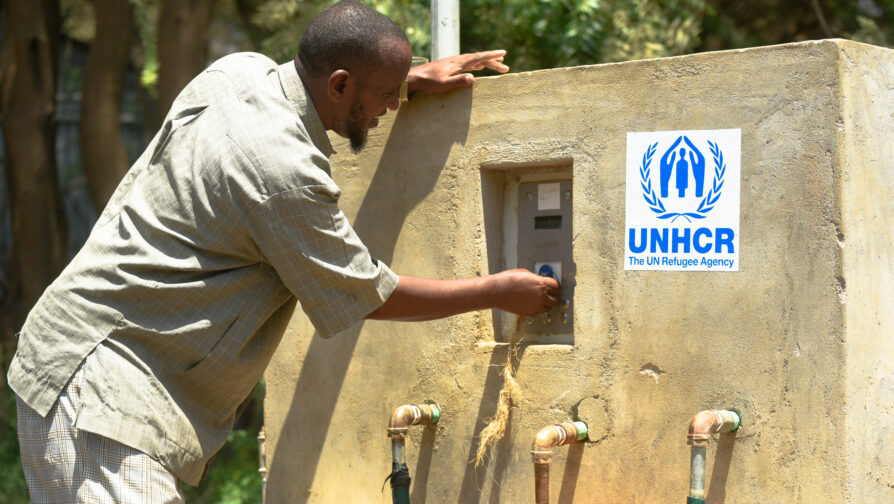The establishment of the water kiosks is part of the Garissa Integrated Socio-Economic Development Plan (GISEDP), allowing refugees and host communities to share sustainable development programmes.
Hassan, a 48-year old Somali refugee is busy working alongside Kahin, a Kenyan Somali. At a busy water point, donkey carts are pulled in and out, towing water from a water Automated Machine (ATM) to supply water to refugees and host community businesses in the market. The two friends have been members of the Dagahaley water and market committees for the last decade.
“We need more ATMs in the camps and settlements”
Stored overnight in an elevated steel tank, water is supplied to the refugee market and nearby host community villages during the day powered by fuel that is bought by water committee. According to the committee officials, the water ATM uses less power, making it easy and cost effective because no grid power is needed, and it has a free or lower charged number of liters per consumer per day. The managers of the water project affirm that its suitable for quick filling even at low pressures and can operate without the presence of a mobile network.
“Since the technology is a success, we need more ATMs in the camps and settlements”, says Kahin who lives in one of the nearby host community villages.”
In March 2020, UNHCR set up the first water ATM in Dagahaley refugee camp, at a time when the world was grappling with corona virus, that requires the constant handwashing with soap and water. UNHCR envisions that the ATMs will be fully operational by end of 2021 in all the three camps.
 The kiosks, which are managed by water and market committees, supply water to refugee and host community businesses in the camps at a fee. The establishment of the water kiosks is part of the Garissa Integrated Socio-Economic Development Plan (GISEDP), allowing refugees and host communities to share sustainable development programmes.
The kiosks, which are managed by water and market committees, supply water to refugee and host community businesses in the camps at a fee. The establishment of the water kiosks is part of the Garissa Integrated Socio-Economic Development Plan (GISEDP), allowing refugees and host communities to share sustainable development programmes.
“We have a bank account with Equity Bank Dadaab and were provided with tokens linked to a Safaricom Mpesa Paybill number by UNHCR and CARE”, says Hassan, water committee member and a resident of the camp.
Kahin, who is also a water committee member notes that they have in one month made sales worth USD 1,000, with a net profit of USD 600 having earned six tokens from their last transaction.
Osman Ahmed, UNHCR’s WASH Officer in Dadaab, notes that money for use at the ATM is loaded through mobile money into the bank account, with a token issued for money paid. It costs four Kenyan shillings (KES) for every 20 litres of water. A CARE Kenya staff, and a member of the market committee monitor the total water dispensed on a daily basis.
“At any one time, members who are custodians of the tokens are free to go to the water dispensing machines and draw water using the token. Every time water is drawn from the ATM, the quantity automatically reduces, until its exhausted.”
The Dagahaley Market Water Committee that is formally registered by Garissa County and social services is run by a group of 12 members equally drawn from refugee and host communities in the Dadaab refugee complex. The committee has a Chair, Deputy Chair, and a treasurer responsible for various tasks in order to ensure the sustainability of the water system.
“The introduction of this (ATM) technology will also help contain fires in the camps”
In 2019, thanks to an idea dubbed ‘sustainability in water’, UNHCR, the UN Refugee Agency, through its Water, Sanitation and Hygiene (WASH) partner, CARE Kenya, set up ATM-style water dispensing kiosks in the three camps of Dadaab refugee complex in Garissa County in Kenya.
The water vending machines is a great breakthrough for business owners in the market that in September 2020 lost property of unknown value because of accidental fire in the main market of Dagahaley camp. The refugees and host communities consider the ATM a game changer for containing fires as trucks can easily load water from ATM machines located in the market.
“The introduction of this (ATM) technology will also help contain fires in the camps”, says Nassir Hassan, one of the shop owners in the market.
UNHCR continues to tap into different innovative approaches in key areas of Cash-Based Interventions (CBI), education, and access to water and energy.
“It is positive to see peaceful coexistence being strengthened by innovative systems and development-centered projects such as these that will benefit both communities”, says Magatte Guisse, UNHCR Head of Operations in Dadaab.
Established in March 1992, Dagahaley currently hosts a refugee population of over 74,000 of the more than 224,000 refugees and asylum-seekers who live in the Dadaab refugee camps. For 14 years, the Dagahaley camp had a population of about 30,000. Between 2006 and 2011, new arrivals settled spontaneously in the outskirts of the camp. A significant number of refugees left spontaneously between 2013 and 2017.
Share on Facebook Share on Twitter